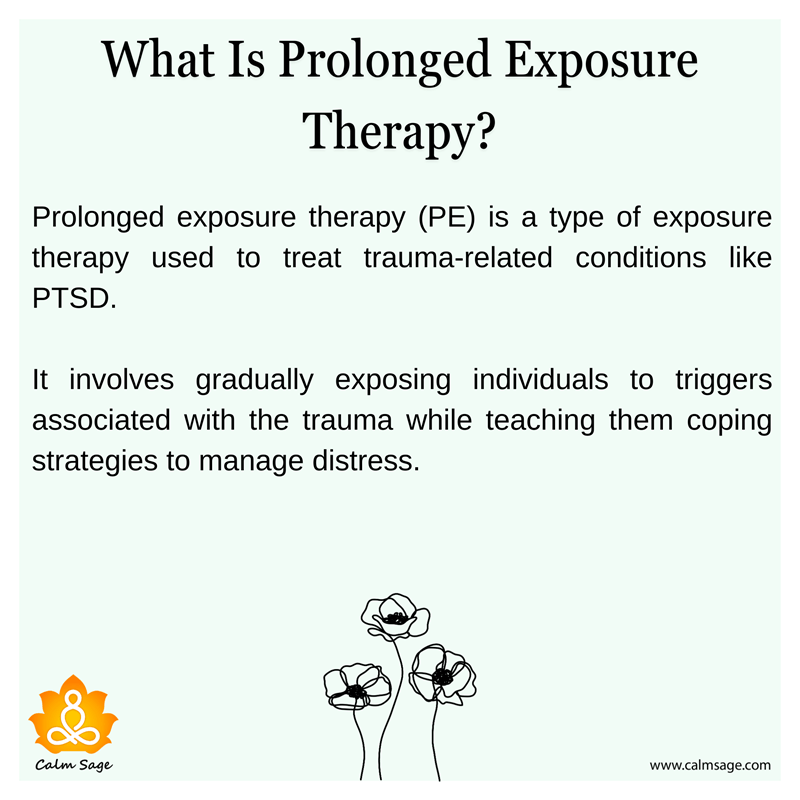Guide-Me: What Is Prolonged Exposure Therapy For PTSD?

Exposure therapy is one of the well-known and effective treatment options to help patients recover from specific phobias, social anxiety, panic disorders, and post-traumatic stress disorder. During ongoing interventions and psychological developments, I have found an effective and best treatment option for treating post-traumatic stress disorder (PTSD).
In this blog, we are going to talk about prolonged exposure therapy for PTSD which is a form of exposure therapy based on approaching trauma-related memories, situations, and feelings. Let’s begin by understanding what prolonged exposure (PE).
What Is Prolonged Exposure Therapy?

Exposure is a well-known technique for confronting fears as it is based on the principles of cognitive behavioral therapy (CBT). Prolonged exposure is also a type of CBT that works in approaching trauma-related situations, memories, and feelings. This therapy was developed to work on each factor related to trauma as it helps in removing fear completely.
During sessions of prolonged exposure therapy, a therapist works on helping the client face fears in a safe environment which eventually helps in reducing the symptoms of PTSD. The main objective of this therapy is to make a client actively learn about their dangerous cues which do not need to be avoided. Research shows that prolonged exposure therapy can be an effective treatment method for treating PTSD.
How Prolonged Exposure Can Be Used For Treating PTSD?
Prolonged exposure therapy generally includes 8 to 15 weekly sessions which usually require three months. Usually, each session consists of 90 minutes but some sessions may extend up to 120 minutes due to profound engagement in exposure and experience processing. The first few sessions of PE include an overview of treatment and an understanding of past experiences.
During these sessions, the therapist also provides psychoeducation and teaches positive coping skills such as different breathing techniques to manage triggers. Additionally, assessments are also conducted before exposure. This treatment can be anxiety-triggering; therefore, proper management is done before triggering the scary stimuli. During exposure imaginal and vivo exposures are used in a safe environment.
Imaginal Exposure
Imaginal exposure is conducted under the guidance of a therapist wherein the patient is described in detail. This helps in processing emotions in a safe environment and breathing techniques are practiced throughout.
In Vivo Exposure
In vivo exposure includes confrontation of feared stimuli in an external space. This exposure is generally assigned as homework wherein the client and therapist identify possible stimuli and connected fears. During this type of exposure, the patient is challenged to confront their feared stimuli and cope with the connected emotion.
What Happens During PE Sessions?
PE is an individual therapy. During the sessions, the therapist and client work together step-by-step in practicing exposure which means that the client faces feared stimuli gradually. With time, the client starts feeling comfortable with feared stimuli. Later, the therapist works on details of trauma such as situations, places, memories, and feelings with the client so that the therapist can help with unprocessed emotions like sadness, anger, or fear.
Benefits of Prolonged Exposure Therapy
Below listed are some of the important benefits of exposure therapy:
- Reduces reactions to feared situations or objects in a safe environment
- Helps in reducing learned associations with feared situations, activities, or objects
- Helps in confronting feared stimuli and managing triggered anxiety with the help of different breathing techniques
- The client learns about more realistic beliefs about feared situations, objects, or activities.
Other Uses of Prolonged Exposure Therapy
Prolonged exposure therapy is not only an effective treatment method for PTSD but it can also be effective for other mental health issues such as:
- Generalized anxiety disorder (GAD)
- Obsessive-compulsive disorder (OCD)
- Panic disorder
- Phobias
- Social anxiety disorder
How To Get Started?
Prolonged exposure is one of the effective treatment options for PTSD. There have been a lot of advancements in prolonged exposure and other types of exposure techniques. In some places or countries, therapists are using virtual reality technology which helps in confronting feelings.
Exposure therapy can be challenging sometimes, but with commitment and effort, it can effectively remove trauma-related memories and feelings.
Here’s a quick checklist to find the right PE therapist:
- How is the therapist going to resolve particular concerns?
- If a therapist dealt with a similar issue before?
- How is your therapist going to process the therapy sessions?
- If your therapist has been approved or certified with PE or not?
- How much experience does your therapist have in treating PTSD?
I hope this blog helps you understand everything you want to know about prolonged exposure therapy for PTSD. For more such content, connect with us through all social media platforms.
Thanks for reading!




















